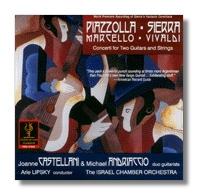
The Internet's Premier Classical Music Source
Related Links
- Latest Reviews
- More Reviews
-
By Composer
-
Collections
DVD & Blu-ray
Books
Concert Reviews
Articles/Interviews
Software
Audio
Search Amazon
Recommended Links
Site News
 CD Review
CD Review
Works for Two Guitars & Orchestra

- Ástor Piazzolla: Double Concerto "Hommage à Liège"
- Alessandro Marcello: Concerto in D minor (orig. for oboe)
- Richard Sierra: Fantasia Corelliana
- Antonio Vivaldi: Concerto in G Major (orig. for two mandolins)
Joanne Castellani, Michael Andriaccio, duo guitarists
Israel Chamber Orchestra/Arie Lipsky
Fleur de Son FDS57952 DDD 55:10
Joanne Castellani and Michael Andriaccio have been performing together since 1975, and have brought their talents not just to various venues in the United States, but also to South America and Europe. Their last Fleur de Son outing was Danzas and More (FDS 57916).
The duo has taken Ástor Piazzolla's 1985 concerto, originally written for guitar and bandoneon (a close relative of the accordion, and Piazzolla's own instrument), and arranged it for two guitars and orchestra. This drastically changes the character of the work, mellowing it out, and short-circuiting the contrasts that Piazzolla built into the solo parts. Having written this, I can report that Castellani and Andriaccio achieve agreeable results with this arrangement, even if they stray from the original's bite and brilliance. The two Baroque concertos also are arrangements. Castellani and Andriaccio are credited with arranging the Marcello; no one is credited with the Vivaldi, perhaps because the work involved in arranging music for two mandolins for two guitars requires less creativity. The Marcello concerto, originally for oboe and orchestra, is the one with the famously melancholy middle movement. As the guitar's tone is intrinsically less plangent than the oboe's, the character of the music is greatly altered in this work too. This matters least in the bustling third movement, where the "nighted colour" found in the first two movements is shaken off. The Vivaldi concerto, a more cheerfwork than the Marcello, takes all the performers into more comfortable territory, for whatever reason. Because this is one of Vivaldi's more popular concertos, Castellani and Andriaccio will be compared with many predecessors on disc. Most listeners will find them to be very relaxed and tonally aware, but hardly proponents of the most up-to-date techniques in Baroque performance practice.
Richard Sierra's neo-Baroque Fantasia Corelliana is the only work of these four to be written for two guitars. In fact, it was commissioned by Fleur de Son for the present performers. In this work, Arcangelo Corelli's music – specifically, its gestures, textures, and shapes – are mimicked and transformed, but not beyond recognition. The opening Grave is very much in the style of Corelli, with the guitars weaving florid lines around an increasingly ornate and fantastic backdrop of strings. The second movement is divided into four sections, with quirky fast music book-ending two slower sections. The brief Vivace third movement features fantastic solo passages for violin. The Finale, again subdivided into smaller sections, brings the Fantasia Corelliana to a charming end.
The Israel Chamber Orchestra isn't suited to the music on this disc. The Piazzolla, an innovative mix of classical music, Argentinean idioms, and jazz, doesn't really set them on fire. Their work is gluey in the Baroque music, and it lacks the polish that one wants in this music. The Sierra Fantasia finds them in better form. As for the guitarists, they acquit themselves well in all four works. As suggested above, this is comfortable music-making. The guitarists don't strain or struggle, they just let the music come out in the easiest way they know. Stylistically, this may disturb scholars of Baroque music (and fans of Ástor Piazzolla), but one can't deny the simple pleasures to be heard here.
Castellani and Andriaccio are not widely separated on the recording's soundstage, but you can tell them apart, not just by placement, but also by tone. The balance between the guitars and the orchestra is fairly good; it is a challenge to keep an orchestra from dominating one (or even two) guitars without resorting to inordinate microphoning or knob-twiddling. The recording was made in Israel in February 2001.
Copyright © 2002, Ray Tuttle




















